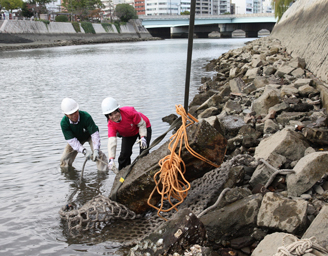On November 24th, the “Association of Hiroshima University for Sending Atomic-Bombed Roof Tiles” (Chairman: Researcher Rebun Kayo) collected a large fragment (stone exposed to A-bomb) from the Motoyasu River that runs near the dome. It seems to be part of the dome's (Former Hiroshima Prefectural Industrial Promotion Hall) 5th floor balcony handrail.
 |
 |
| The A-bomb fragment collected from the Motoyasu River |
Professor Satoda explaining the fragment to students on a school excursion from Saitama prefecture (He is wearing a white helmet in the right bottom corner) |
This association has been collecting Atomic Dome fragments from the Motoyasu River since 2013. The existence of this large fragment was confirmed before the extraction, but the specific place where the fragment used to be was not identified at the time. They were able to identify the specific place with the help of the Hiroshima University Research Institute for Radiation Biology and Medicine, Division of Radiation Information Registry. This year, the association received a clear exterior photograph of the Atomic Dome before the bombing.
Foreign tourists and students on their school excursion watched over attentively as the extraction took place with a crane truck. At the same time, Researcher Kayo and Hiroshima University Faculty of Medicine (Department of Medicine) 1st year student Nao Yamada collected small fragments from the cold river. Also, Professor Takahiro Satoda (Graduate School of Biomedical & Health Sciences) explained about the fragments.
The collected fragments were transported to the Hiroshima University Kasumi campus, Institute of History of Medicine. The fragments are scheduled to be on display in this institute next April after thorough investigation, cleaning, salt removal, and preparation of explanation panels.
Researcher Kayo says, “A fragment of the Atomic Dome will be exhibited in the Institute of History of Medicine, which is a building exposed to the atomic bomb itself. It is a very moving moment. I would like people to think of the atomic bomb victims when they actually see the fragment. Also, I want people within and outside of Japan to feel the terrors of A-bombs.”
 |
 |
| Researcher Kayo (left) and Ms Yamada collecting other fragments | Installation operation of the fragment in front of the Institute of History of Medicine |
【Inquiries】
Education and International Office, International Exchange Group
Rebun Kayo
FAX: 082-424-4545

 Home
Home














